We set out from Portland in early June and made our way directly to the coast. The U.S. Pacific Coast Highway—from Washington to Southern California—is the most bicycled route in the country. And why not? It’s full of beautiful coastal scenery from top to bottom. Rugged coastline and the occasional walkable beach makes it a great destination for cyclists.
Not that you’d be taking a dip at any of those beaches. One thing is for sure—the Pacific coast of Oregon and Northern California is COLD. My southern brain has a hard time computing the need to wear fleece-lined tights, a long-sleeved jersey, a rain jacket and a hat in the middle of June! For goodness’ sake, it’s supposed to be HOT in June! Not only is it cool in this area because of what the locals call “natural air conditioning” (i.e., the Pacific Ocean), we were struck with an unusually bad streak of weather. On our nasty weather days, we had rain, cold wind in our faces, more rain, and fog that kept us from seeing much of anything.
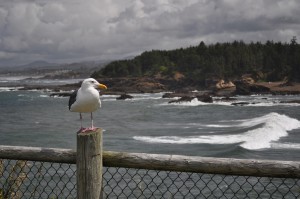
At least this day wasn’t foggy like so many were, but this heavy cloud cover on the Oregon coast certainly kept the sun from warming things up!
But… on the four or five days it was nice, it was REALLY nice: we had a perfect tailwind, sunshine, and stunning coastal cliff views.
And fortunately, it was on one of these nice days that we rolled over 30,000 kilometers!
Another benefit of cycling the coastal route is that you pass through the area of California with the largest concentration of old-growth Redwood forests. We took a day off in Prairie Creek State Park, where we took a few hours to hike among these ancient trees, many of which are 2,000 years old!
A few days further south, we rode through the famed “Avenue of the Giants.” Aptly named, this 31-mile scenic route takes you right through the heart of Redwood country.
A Fine Line…
One thing that has marked our journey southward along the Pacific has been an increased difficulty in free camping. Months ago, I emailed a friend of ours who is “Cycling the 6,” headed north through the U.S., and gave him what I thought was all kinds of great advice about how easy free camping is in the United States. Of course, all that information was based on our own experience in the East. What I didn’t realize is that the West Coast is a completely different story.
What makes it so different? One word: transients. This word has been added as a regular part of our vocabulary. It’s a term that generally applies to the population of mostly homeless people on their move up and down the Pacific Coast. Many have backpacks, some are on bikes… and to be honest, there’s only a fine line between us and them. I suppose the biggest difference would be that we have a clear course and final destination… and have chosen this lifestyle for a season of our lives. Of course, we’re more prepared than them in most situations as well, for example, we have great jackets when cycling in the rain, and we have waterproof bags and a sturdy tent to sleep in. But, at the end of the day, we share one huge thing in common—we’re all looking for a place to lay our heads and spend the night undisturbed.
Unfortunately, the size of this transient population is exactly what makes this task difficult. In many towns along the coast, we stopped toward the end of the day to search out free campsites—only to find that the most ideal spots were quite clearly “already taken.” And because there are somewhat established locations where these people sleep, the police more regularly come through and clear those areas. Not to mention that we didn’t really want to show up in the transient camp area with all our stuff and our nice tent… we just didn’t think that would send the best message.
Add to the transient population the large number of touring cyclists, and you have yourself the recipe for virtually no free campsites. What do most people do? Well the nice thing is that most of the state parks along the coast offer what is called “hiker-biker” camping areas. If you show up on foot or on a bicycle, you can camp in these areas for $5 or $6 per person. So most people happily plan their route to be in a state park each night. While we used this on many occasions, we knew that for two of us ($10-$12 per night), that would still be too expensive to do every night.
Interestingly enough, it’s because of this difficulty with free camping that we were put in more positions to meet amazing people.
The People Make the Journey
One of the things we looked forward to most about coming back to the United States was the people we would connect with along the way. Engaging with people happens more naturally in your own culture and language. But even the expectations we had have been exceeded. We have been blown away by the kindness and hospitality of the people we’ve met along the West Coast. Here’s a few stories.
We stopped late in the evening in the small (think 600 people) town of Yachats, Oregon. Because of the free camping dilemma, we planned to ask permission at a church. The town only had two, and we saw cars outside the Presbyterian church, so we decided to cook dinner in the nearby park and watch for the people to leave the evening meeting. When they came out about an hour later, Dave tracked down the pastor to ask if we could camp. He was hesitant about allowing that at the church without having an opinion from the congregation, but then asked if we were familiar with warmshowers… because he is a host on warmshowers! Well, of course we are! He invited us over to his house to spend the evening—which included a shower, laundry and great conversation. Amazing!
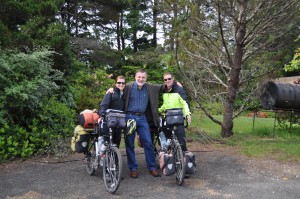
Brian had also done a long cycling trip himself–a 4,000 mile pilgrimage. Always fun to meet other cyclists!
And would you believe that just one week later, we stopped at a church in Eureka, California, and almost the exact same thing happened? We looked up a church on the internet, just so we could have a specific location to go and ask. We showed up and asked a guy in the parking lot if he knew if we would be able to camp there… and he instantly escorted us to the church office. Before we knew it, we were being ushered into the pastor’s office, where he began to ask us if we had ever heard of warmshowers. An hour later, we were pulling up to Matt’s house and getting settled into the guest area, where we were able to grill up a fine dinner on their barbecue and wash our clothes once again.
And in between these two spontaneous warmshowers, we stopped in the small town of Crescent City for a Sunday morning church service. While we were there, we met Juan Romero. Juan was leading worship that morning and introduced himself to us during the “meet & greet” part of the service. Later that day, we bumped into him at Safeway as we were loading up our bags to head off to the state park about 40 miles up the road. Juan invited us to a cookout at another small church that he pastors in the area—All Tribes Four Square Church. While he went inside the grocery store, we discussed our options. We could press on to the state park as planned, or we could stay in town and join the cookout for the afternoon, putting us one day later than we had intended. But once again, we decided this trip is about the people we meet and the relationships we make along the way. So we decided to stay. And no regrets! Our short visit in Crescent City turned out to be one of the highlights of our entire time on the West Coast. We enjoyed fellowship with other believers at the church cookout… and actually their church reminded us so much of the one we were a part of when we lived in Auburn. We got to know the whole Romero family over the next half day… and we were blessed beyond measure. We can’t even begin to sum up how much we enjoyed this short stay. And once again, we’d say that the people are absolutely the best part of the journey.
Last but not least, the day before we rode into San Francisco, we met up with Tim Cowman. We met Tim on an overnight boat trip in Halong Bay, Vietnam, almost six months ago. We exchanged contact information, and he told us that if we would be riding down the West Coast, we should give him a call and he’d show us around his part of the world. I think he was a bit surprised and impressed that we actually took him up on it! We spent two nights at Tim’s, and he showed us around Point Reyes, the only national seashore on the West Coast. The weather didn’t really cooperate for the most scenic tour, but we had a great time cruising around in his “man van” and reminiscing about all our experiences from traveling in Southeast Asia.
And now we’re done with the coast. As we came into San Francisco, we’ve turned inland for the last time on this journey. From now until Alabama, we’ll be landlocked. We’ll miss the coast. We’re realizing how much of our journey has been along the water. The whole thing started with a glimpse of the Atlantic from Maine on our first day. We rode along the Pacific in Central America and in Peru. We spent time along the North, Adriatic and Aegean seas in Europe. And of course we were back to the Pacific in Vietnam, then the Gulf of Thailand and the Andaman Sea further south. So many stages of our journey have been marked by riding along the coast—smelling the salty air and feeling the stiff sea breeze. But no more. And the end of coastal riding marks the end of another chapter of this whole world tour adventure. It makes us more aware of our proximity to home—both in time and distance. We’re headed in that direction… and we’re getting excited.
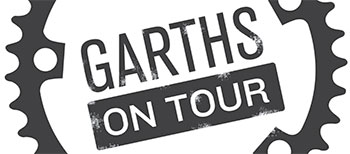
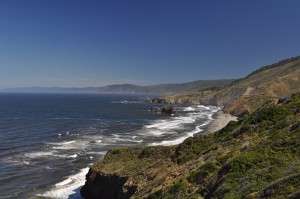
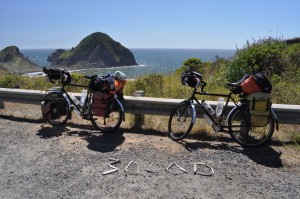
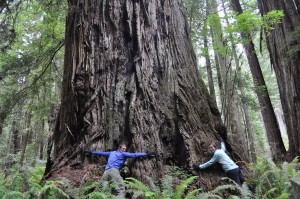
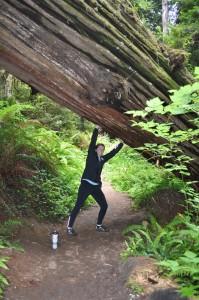
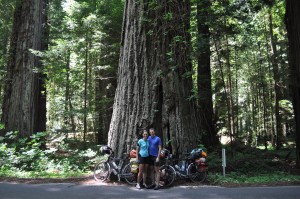
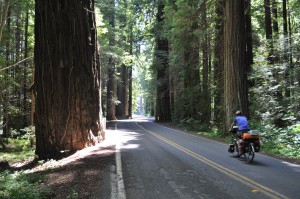
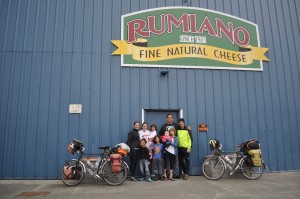
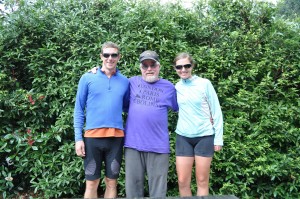
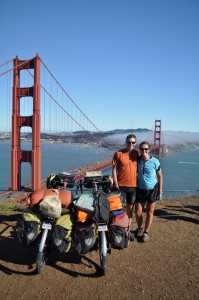
3 comments
Thomas says:
Jul 1, 2013
Warmshower power !
Tim Cowman says:
Jul 8, 2013
Hey Guys,
Read your blog, very impressive! The day you left I went out with Fred and go the biggest salmon of the season thus far, 40 lbs on the hook. If you check, http://fishlawsons.blogspot.com/2013/06/heres-wednesday-fish-of-note-submitted.html, you’ll see the fish. You should’ve stayed another day! Call me when you get done with your trip, as you know I don’t do emails. You can reach me at (415) 663-8269. Cheers for now!
Tim
Stephen Touset says:
Jul 8, 2013
Godspeed heading East, you guys!